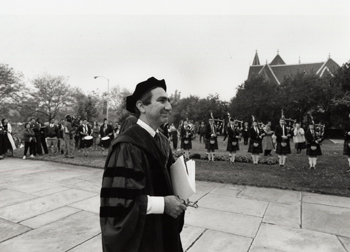 |
|
|||||||||
|
1913 The Reynolds Club, now open to the entire student body, was once an exclusive men’s club with "active" and "associate" student members. In December 1913 the club raised $1,000 to furnish a library, with titles determined by a members’ survey. The December Magazine noted other recent improvements that reveal a very different Reynolds Club from the one today’s students inhabit: "the installation of eight oak wardrobes in the billiard room…a new cigar stand and humidor at a cost of $300, a new pin-setting machine for the bowling alleys, and 60 new ivory-tipped cues."
1953 After a newspaper reporter interviewing President Lawrence Kimpton misquoted him as favoring football’s return to the University, a rumor blossomed that the administration was planning to reinstate the University in the Big Ten, 14 years after Chicago had withdrawn from competition as a major college-football powerhouse. The notion was coldly received by faculty and students alike: T. Nelson Metcalf, director of athletics, denied the Big Ten rumor as "ridiculous." The Maroon came down even harder: "the football player is seldom a student—he is merely a 200-plus pound monster in shoulder-pads who will receive a degree in Physical Education for cavorting before 80,000 wildly cheering fans." 1978 The Winter issue featured a short memoir, “Hyde Park Childhood,” by Dorothy Michelson Livingston, daughter of professor Albert A. Michelson, the first American to win the Nobel Prize in Physics. Livingston’s recollections of "growing up in the shadow of this great University" range from the scientific to the delinquent, including weekend demonstrations in her father’s laboratory on how to measure the speed of light, and her sister and her best friend burglarizing Robie House. After scaling a wall and entering through an unlocked door, they treated themselves to a pantry full of jellies and jams. When Mrs. Robie returned home, she treated them to "a lecture on the evils of illegal entry and theft." 1993 The University’s 11th president, Hugo Sonnenschein, was inaugurated October 20. The damp, overcast day was a whirlwind of ceremonial processions, faculty speeches, conferrals of honorary degrees, and, finally, dinner and dancing for the former Princeton economist. Inauguration day was an occasion for debate as much as for pleasantry, with many speakers, including the new president, reflecting on the financial, technological, and ideological hardships facing U.S. universities. But by the end of the day Sonnenschein could be found in jeans and a Chicago sweatshirt, line-dancing in Ida Noyes Hall.—J.N.L.
|
|
Contact
|

 FROM
OUR PAGES
FROM
OUR PAGES